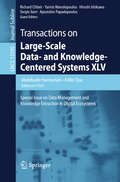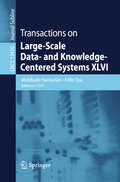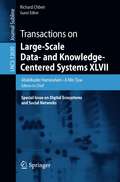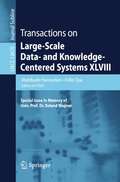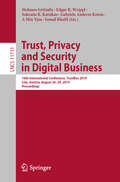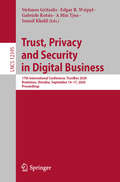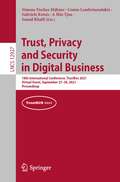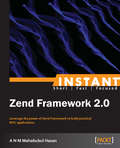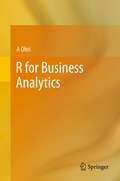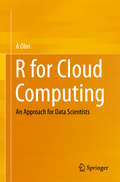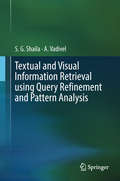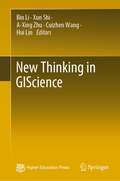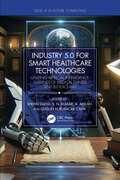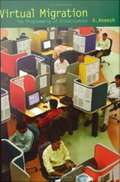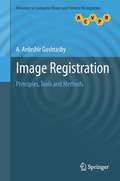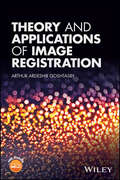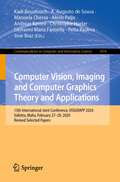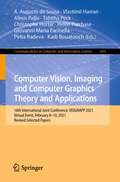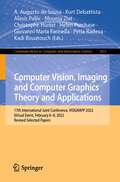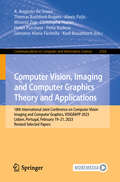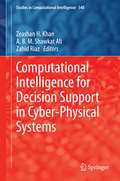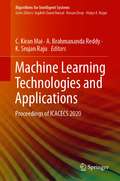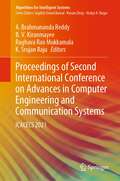- Table View
- List View
Transactions on Large-Scale Data- and Knowledge-Centered Systems XLV: Special Issue on Data Management and Knowledge Extraction in Digital Ecosystems (Lecture Notes in Computer Science #12390)
by Richard Chbeir Abdelkader Hameurlain Yannis Manolopoulos A Min Tjoa Hiroshi Ishikawa Sergio Ilarri Apostolos PapadopoulosThe LNCS journal Transactions on Large-Scale Data- and Knowledge-Centered Systems focuses on data management, knowledge discovery, and knowledge processing, which are core and hot topics in computer science. Since the 1990s, the Internet has become the main driving force behind application development in all domains. An increase in the demand for resource sharing (e.g., computing resources, services, metadata, data sources) across different sites connected through networks has led to an evolution of data- and knowledge-management systems from centralized systems to decentralized systems enabling large-scale distributed applications providing high scalability. This, the 45th issue of Transactions on Large-Scale Data- and Knowledge-Centered Systems, contains eight revised selected regular papers. Topics covered include data analysis, information extraction, blockchains, and big data.
Transactions on Large-Scale Data- and Knowledge-Centered Systems XLVI (Lecture Notes in Computer Science #12410)
by Abdelkader Hameurlain A Min TjoaThe LNCS journal Transactions on Large-Scale Data- and Knowledge-Centered Systems focuses on data management, knowledge discovery, and knowledge processing, which are core and hot topics in computer science. Since the 1990s, the Internet has become the main driving force behind application development in all domains. An increase in the demand for resource sharing (e.g., computing resources, services, metadata, data sources) across different sites connected through networks has led to an evolution of data- and knowledge-management systems from centralized systems to decentralized systems enabling large-scale distributed applications providing high scalability. This, the 46th issue of Transactions on Large-Scale Data- and Knowledge-Centered Systems, contains six fully revised selected regular papers. Topics covered include an elastic framework for genomic data management, medical data cloud federations, temporal pattern mining, scalable schema discovery, load shedding, and selectivity estimation using linked Bayesian networks.
Transactions on Large-Scale Data- and Knowledge-Centered Systems XLVII: Special Issue on Digital Ecosystems and Social Networks (Lecture Notes in Computer Science #12630)
by Richard Chbeir Abdelkader Hameurlain A Min TjoaThe LNCS journal Transactions on Large-Scale Data- and Knowledge-Centered Systems focuses on data management, knowledge discovery, and knowledge processing, which are core and hot topics in computer science. Since the 1990s, the Internet has become the main driving force behind application development in all domains. An increase in the demand for resource sharing across different sites connected through networks has led to an evolution of data- and knowledge-management systems from centralized systems to decentralized systems enabling large-scale distributed applications providing high scalability.This, the 47th issue of Transactions on Large-Scale Data- and Knowledge-Centered Systems, constitutes a special issue focusing on Digital Ecosystems and Social Networks. The 9 revised selected papers cover topics that include Social Big Data, Data Analysis, Cloud-Based Feedback, Experience Ecosystems, Pervasive Environments, and Smart Systems.
Transactions on Large-Scale Data- and Knowledge-Centered Systems XLVIII: Special Issue In Memory of Univ. Prof. Dr. Roland Wagner (Lecture Notes in Computer Science #12670)
by Abdelkader Hameurlain A Min TjoaThe LNCS journal Transactions on Large-Scale Data- and Knowledge-Centered Systems focuses on data management, knowledge discovery, and knowledge processing, which are core and hot topics in computer science. Since the 1990s, the Internet has become the main driving force behind application development in all domains. An increase in the demand for resource sharing (e.g., computing resources, services, metadata, data sources) across different sites connected through networks has led to an evolution of data- and knowledge management systems from centralized systems to decentralized systems enabling large-scale distributed applications providing high scalability. This, the 48th issue of Transactions on Large-Scale Data- and Knowledge-Centered Systems, contains 8 invited papers dedicated to the memory of Prof. Dr. Roland Wagner. The topics covered include distributed database systems, NewSQL, scalable transaction management, strong consistency, caches, data warehouse, ETL, reinforcement learning, stochastic approximation, multi-agent systems, ontology, model-driven development, organisational modelling, digital government, new institutional economics and data governance.
Trust, Privacy and Security in Digital Business: 16th International Conference, TrustBus 2019, Linz, Austria, August 26–29, 2019, Proceedings (Lecture Notes in Computer Science #11711)
by Sokratis K. Katsikas Ismail Khalil A Min Tjoa Stefanos Gritzalis Gabriele Anderst-Kotsis Edgar R. WeipplThis book constitutes the refereed proceedings of the 16th International Conference on Trust, Privacy and Security in Digital Business, TrustBus 2019, held in Linz, Austria, in August 2019 in conjunction with DEXA 2019. The 11 full papers presented were carefully reviewed and selected from 24 submissions. The papers are organized in the following topical sections: privacy; and audit, compliance and threat intelligence.The chapter "A data utility-driven benchmark for de-identification methods" is open access under a CC BY 4.0 license at link.springer.com.
Trust, Privacy and Security in Digital Business: 17th International Conference, TrustBus 2020, Bratislava, Slovakia, September 14–17, 2020, Proceedings (Lecture Notes in Computer Science #12395)
by Ismail Khalil A Min Tjoa Stefanos Gritzalis Edgar R. Weippl Gabriele KotsisThis book constitutes the refereed proceedings of the 17th International Conference on Trust, Privacy and Security in Digital Business, TrustBus 2020, held in Bratislava, Slovakia, in September 2020. The conference was held virtually due to the COVID-19 pandemic. The 11 full and 4 short papers presented were carefully reviewed and selected from 28 submissions. The papers are organized in the following topical sections: blockchain, cloud security/hardware; economics/privacy; human aspects; privacy; privacy and machine learning; trust.
Trust, Privacy and Security in Digital Business: 18th International Conference, TrustBus 2021, Virtual Event, September 27–30, 2021, Proceedings (Lecture Notes in Computer Science #12927)
by Costas Lambrinoudakis Simone Fischer-Hübner Ismail Khalil A Min Tjoa Gabriele KotsisThis volume LNCS 12927 constitutes the papers of the 18th International Conference on Trust, Privacy and Security in Digital Business, TrustBus 2021, held in September 2021 as part of the DEXA 2021 conference. The event was held virtually due to COVID-19 pandemic. The 11 full papers presented were carefully reviewed and selected from 30 submissions regarding advancements in the state of the art and practice of trust and privacy in digital business. The papers are organized in topical sections: Trust Evaluation; Security Risks; Web Security; Data Protection and Privacy Controls; and Privacy and Users
Instant Zend Framework 2.0
by A N HasanGet to grips with a new technology, understand what it is and what it can do for you, and then get to work with the most important features and tasks. This book is fast-paced, practical guide that will provide step-by-step instructions for building a practical database-driven MVC application using Zend Framework 2.This book is for developers who possess entry level knowledge or who have no prior experience with Zend Framework. An understanding of object-oriented programming is important and experience with namespaces will be required.
R for Business Analytics
by A OhriR for Business Analytics looks at some of the most common tasks performed by business analysts and helps the user navigate the wealth of information in R and its 4000 packages. With this information the reader can select the packages that can help process the analytical tasks with minimum effort and maximum usefulness. The use of Graphical User Interfaces (GUI) is emphasized in this book to further cut down and bend the famous learning curve in learning R. This book is aimed to help you kick-start with analytics including chapters on data visualization, code examples on web analytics and social media analytics, clustering, regression models, text mining, data mining models and forecasting. The book tries to expose the reader to a breadth of business analytics topics without burying the user in needless depth. The included references and links allow the reader to pursue business analytics topics. This book is aimed at business analysts with basic programming skills for using R for Business Analytics. Note the scope of the book is neither statistical theory nor graduate level research for statistics, but rather it is for business analytics practitioners. Business analytics (BA) refers to the field of exploration and investigation of data generated by businesses. Business Intelligence (BI) is the seamless dissemination of information through the organization, which primarily involves business metrics both past and current for the use of decision support in businesses. Data Mining (DM) is the process of discovering new patterns from large data using algorithms and statistical methods. To differentiate between the three, BI is mostly current reports, BA is models to predict and strategize and DM matches patterns in big data. The R statistical software is the fastest growing analytics platform in the world, and is established in both academia and corporations for robustness, reliability and accuracy. The book utilizes Albert Einstein's famous remarks on making things as simple as possible, but no simpler. This book will blow the last remaining doubts in your mind about using R in your business environment. Even non-technical users will enjoy the easy-to-use examples. The interviews with creators and corporate users of R make the book very readable. The author firmly believes Isaac Asimov was a better writer in spreading science than any textbook or journal author.
R for Cloud Computing
by A OhriR for Cloud Computing looks at some of the tasks performed by business analysts on the desktop (PC era) and helps the user navigate the wealth of information in R and its 4000 packages as well as transition the same analytics using the cloud. With this information the reader can select both cloud vendors and the sometimes confusing cloud ecosystem as well as the R packages that can help process the analytical tasks with minimum effort, cost and maximum usefulness and customization. The use of Graphical User Interfaces (GUI) and Step by Step screenshot tutorials is emphasized in this book to lessen the famous learning curve in learning R and some of the needless confusion created in cloud computing that hinders its widespread adoption. This will help you kick-start analytics on the cloud including chapters on both cloud computing, R, common tasks performed in analytics including the current focus and scrutiny of Big Data Analytics, setting up and navigating cloud providers. Readers are exposed to a breadth of cloud computing choices and analytics topics without being buried in needless depth. The included references and links allow the reader to pursue business analytics on the cloud easily. It is aimed at practical analytics and is easy to transition from existing analytical set up to the cloud on an open source system based primarily on R. This book is aimed at industry practitioners with basic programming skills and students who want to enter analytics as a profession. Note the scope of the book is neither statistical theory nor graduate level research for statistics, but rather it is for business analytics practitioners. It will also help researchers and academics but at a practical rather than conceptual level. The R statistical software is the fastest growing analytics platform in the world, and is established in both academia and corporations for robustness, reliability and accuracy. The cloud computing paradigm is firmly established as the next generation of computing from microprocessors to desktop PCs to cloud.
Textual and Visual Information Retrieval using Query Refinement and Pattern Analysis
by S. G. Shaila A VadivelThis book offers comprehensive coverage of information retrieval by considering both Text Based Information Retrieval (TBIR) and Content Based Image Retrieval (CBIR), together with new research topics. The approach to TBIR is based on creating a thesaurus, as well as event classification and detection. N-gram thesaurus generation for query refinement offers a new method for improving the precision of retrieval, while event classification and detection approaches aid in the classification and organization of information using web documents for domain-specific retrieval applications. In turn, with regard to content based image retrieval (CBIR) the book presents a histogram construction method, which is based on human visual perceptions of color. The book’s overarching goal is to introduce readers to new ideas in an easy-to-follow manner.
New Thinking in GIScience
by Bin Li Hui Lin Xun Shi A-Xing Zhu Cuizhen WangThis book is a collection of seminal position essays by leading researchers on new development in Geographic Information Sciences (GIScience), covering a wide range of topics and representing a variety of perspectives. The authors propose enrichments and extensions to the conceptual framework of GIScience; discuss a series of transformational methodologies and technologies for analysis and modeling; elaborate on key issues in innovative approaches to data acquisition and integration, across earth sensing to social sensing; and outline frontiers in application domains, spanning from natural science to humanities and social science, e.g., urban science, land use and planning, social governance, transportation, crime, and public health, just name a few. The book provides an overview of the strategic directions on GIScience research and development. It will benefit researchers and practitioners in the field who are seeking a high-level reference regarding those directions.
Industry 5.0 for Smart Healthcare Technologies: Utilizing Artificial Intelligence, Internet of Medical Things and Blockchain (ISSN)
by Sherin Zafar S. N. Kumar A. Ahilan Gulsun Kurubacak CakirIn this book, the role of Artificial Intelligence (AI), Internet of Things (IoT) and Blockchain in smart healthcare is explained through a detailed study of Artificial Neural Network, Fuzzy Set Theory, Intuitionistic Fuzzy Set, Machine Learning and Big Data technology.Industry 5.0 for Smart Healthcare Technologies: Utilizing Artificial Intelligence, Internet of Medical Things and Blockchain focuses on interesting applications of AI, promising advancements in IoT and important findings in Blockchain technology. When applied to smart healthcare technologies, Industry 5.0 offers numerous benefits that can revolutionize the healthcare industry. This book provides readers with insights and tools for enhanced patient care, remote patient monitoring, predictive analytics and early intervention of diseases, seamless data sharing and interoperability, telemedicine and virtual care, and a safer and more secure healthcare ecosystem. The authors examine novel computational algorithms for the processing of medical images, as well as novel algorithms for the processing of biosignals in detection of diseases. This book also explores systems for processing physiological parameters and discusses applications of AI techniques in the broader healthcare industry. The authors also investigate the importance of Augment Reality/Virtual Relatity (AR/VR) in the healthcare sector and examine the futuristic applications of Industry 5.0 in the healthcare sector.This book is intended for researchers and professionals working in interdisciplinary fields of computer engineering/science and healthcare. It will provide them with the tools to enhance diagnostics, optimize treatment plans, and empower patients to actively participate in their healthcare journey.
Virtual Migration: The Programming of Globalization
by A. AneeshAneesh draws on the sociology of science, social theory, and research on migration to illuminate the practical and theoretical ramifications of virtual migration.
Image Registration
by A. Ardeshir GoshtasbyThis book presents a thorough and detailed guide to image registration, outlining the principles and reviewing state-of-the-art tools and methods. The book begins by identifying the components of a general image registration system, and then describes the design of each component using various image analysis tools. The text reviews a vast array of tools and methods, not only describing the principles behind each tool and method, but also measuring and comparing their performances using synthetic and real data. Features: discusses similarity/dissimilarity measures, point detectors, feature extraction/selection and homogeneous/heterogeneous descriptors; examines robust estimators, point pattern matching algorithms, transformation functions, and image resampling and blending; covers principal axes methods, hierarchical methods, optimization-based methods, edge-based methods, model-based methods, and adaptive methods; includes a glossary, an extensive list of references, and an appendix on PCA.
Theory and Applications of Image Registration
by A. Ardeshir GoshtasbyA hands-on guide to image registration theory and methods—with examples of a wide range of real-world applications Theory and Applications of Image Registration offers comprehensive coverage of feature-based image registration methods. It provides in-depth exploration of an array of fundamental issues, including image orientation detection, similarity measures, feature extraction methods, and elastic transformation functions. Also covered are robust parameter estimation, validation methods, multi-temporal and multi-modality image registration, methods for determining the orientation of an image, methods for identifying locally unique neighborhoods in an image, methods for detecting lines in an image, methods for finding corresponding points and corresponding lines in images, registration of video images to create panoramas, and much more. Theory and Applications of Image Registration provides readers with a practical guide to the theory and underpinning principles. Throughout the book numerous real-world examples are given, illustrating how image registration can be applied to problems in various fields, including biomedicine, remote sensing, and computer vision. Also provided are software routines to help readers develop their image registration skills. Many of the algorithms described in the book have been implemented, and the software packages are made available to the readers of the book on a companion website. In addition, the book: Explores the fundamentals of image registration and provides a comprehensive look at its multi-disciplinary applications Reviews real-world applications of image registration in the fields of biomedical imaging, remote sensing, computer vision, and more Discusses methods in the registration of long videos in target tracking and 3-D reconstruction Addresses key research topics and explores potential solutions to a number of open problems in image registration Includes a companion website featuring fully implemented algorithms and image registration software for hands-on learning Theory and Applications of Image Registration is a valuable resource for researchers and professionals working in industry and government agencies where image registration techniques are routinely employed. It is also an excellent supplementary text for graduate students in computer science, electrical engineering, software engineering, and medical physics.
Computer Vision, Imaging and Computer Graphics Theory and Applications: 15th International Joint Conference, VISIGRAPP 2020 Valletta, Malta, February 27–29, 2020, Revised Selected Papers (Communications in Computer and Information Science #1474)
by Petia Radeva Giovanni Maria Farinella Andreas Kerren Christophe Hurter Manuela Chessa Kadi Bouatouch Alexis Paljic A. Augusto de Sousa Jose BrazThis book constitutes thoroughly revised and selected papers from the 15th International Joint Conference on Computer Vision, Imaging and Computer Graphics Theory and Applications, VISIGRAPP 2020, held in Valletta, Malta, in February 2020.The 25 thoroughly revised and extended papers presented in this volume were carefully reviewed and selected from 455 submissions. The papers contribute to the understanding of relevant trends of current research on computer graphics; human computer interaction; information visualization; computer vision.
Computer Vision, Imaging and Computer Graphics Theory and Applications: 16th International Joint Conference, Visigrapp 2021, Vienna, Austria, February 8-10, 2021, Revised Selected Papers (Communications In Computer And Information Science Series #1691)
by Petia Radeva Giovanni Maria Farinella Helen Purchase Christophe Hurter Kadi Bouatouch Alexis Paljic A. Augusto de Sousa Vlastimil Havran Tabitha Peck<p>This book constitutes the refereed proceedings of the 16th International Joint Conference on Computer Vision, Imaging and Computer Graphics Theory and Applications, VISIGRAPP 2021, held as a virtual event, February 8–10, 2021.<p> <p>The 16 full papers presented in this volume were carefully reviewed and selected from 371 submissions. The purpose of VISIGRAPP is to bring together researchers and practitioners interested in both theoretical advances and applications of computer vision, computer graphics and information visualization. VISIGRAPP is composed of four co-located conferences, each specialized in at least one of the aforementioned main knowledge areas, namely GRAPP, IVAPP, HUCAPP and VISAPP.<p> <p>The contributions were organized in topical sections as follows: Computer Graphics Theory and Applications; Human Computer Interaction Theory and Applications; Information Visualization Theory and Applications; Computer Vision Theory and Applications.<p>
Computer Vision, Imaging and Computer Graphics Theory and Applications: 17th International Joint Conference, VISIGRAPP 2022, Virtual Event, February 6–8, 2022, Revised Selected Papers (Communications in Computer and Information Science #1815)
by Petia Radeva Giovanni Maria Farinella Helen Purchase Christophe Hurter Kurt Debattista Kadi Bouatouch Alexis Paljic A. Augusto de Sousa Mounia ZiatThis book constitutes the referred proceedings of the 17th International Joint Conference on Computer Vision, Imaging and Computer Graphics Theory and Applications, VISIGRAPP 2022, Virtual Event, February 6–8, 2022. The 15 full papers included in this book were carefully reviewed and selected from 392 submissions. The purpose of VISIGRAPP is to bring together researchers and practitioners interested in both theoretical advances and applications of computer vision, computer graphics and information visualization. VISIGRAPP is composed of four co-located conferences, each specialized in at least one of the aforementioned main knowledge areas, namely GRAPP, IVAPP, HUCAPP and VISAPP.
Computer Vision, Imaging and Computer Graphics Theory and Applications: 18th International Joint Conference on Computer Vision, Imaging and Computer Graphics, VISIGRAPP 2023, Lisbon, Portugal, February 19–21, 2023, Revised Selected Papers (Communications in Computer and Information Science #2103)
by Petia Radeva Giovanni Maria Farinella Helen Purchase Christophe Hurter Kadi Bouatouch Alexis Paljic A. Augusto de Sousa Mounia Ziat Thomas Bashford-RogersThis book constitutes the refereed post-conference proceedings of the 19th International Joint Conference on Computer Vision, Imaging and Computer Graphics Theory and Applications, VISIGRAPP 2023, held in Lisbon, Portugal, during February 19–21, 2023. The 17 revised full papers presented were carefully selected from 395 submissions. VISIGRAPP aims to bring together researchers and practitioners interested in theoretical advances and applications of computer vision, information visualization, computer graphics and interaction.
Big Data Intelligence and Computing: International Conference, DataCom 2022, Denarau Island, Fiji, December 8–10, 2022, Proceedings (Lecture Notes in Computer Science #13864)
by Ching-Hsien Hsu A. B. M. Shawkat Ali Hung Cao Mengwei Xu Hojjat BaghbanThis book constitutes the proceedings of the International Conference on Big Data Intelligence and Computing, DataCom 2022, which took place in Denarau Island, Fiji, in December 2022. The 30 full papers included in this volume were carefully reviewed and selected from 88 submissions. The papers detail big data analytics solutions, distributed computation paradigms, on-demand services, autonomic systems, and pervasive applications.
Computational Intelligence for Decision Support in Cyber-Physical Systems (Studies in Computational Intelligence #540)
by Zeashan H Khan A. B. M. Shawkat Ali Zahid RiazThis book is dedicated to applied computational intelligence and soft computing techniques with special reference to decision support in Cyber Physical Systems (CPS), where the physical as well as the communication segment of the networked entities interact with each other. The joint dynamics of such systems result in a complex combination of computers, software, networks and physical processes all combined to establish a process flow at system level. This volume provides the audience with an in-depth vision about how to ensure dependability, safety, security and efficiency in real time by making use of computational intelligence in various CPS applications ranging from the nano-world to large scale wide area systems of systems. Key application areas include healthcare, transportation, energy, process control and robotics where intelligent decision support has key significance in establishing dynamic, ever-changing and high confidence future technologies. A recommended text for graduate students and researchers working on the applications of computational intelligence methods in CPS.
Geometric Methods in Signal and Image Analysis
by Hamid Krim A. Ben HamzaThis comprehensive guide offers a new approach for developing and implementing robust computational methodologies that uncover the key geometric and topological information from signals and images. With the help of detailed real-world examples and applications, readers will learn how to solve complex signal and image processing problems in fields ranging from remote sensing to medical imaging, bioinformatics, robotics, security, and defence. With an emphasis on intuitive and application-driven arguments, this text covers not only a range of methods in use today, but also introduces promising new developments for the future, bringing the reader up-to-date with the state of the art in signal and image analysis. Covering basic principles as well as advanced concepts and applications, and with examples and homework exercises, this is an invaluable resource for graduate students, researchers, and industry practitioners in a range of fields including signal and image processing, biomedical engineering, and computer graphics.
Machine Learning Technologies and Applications: Proceedings of ICACECS 2020 (Algorithms for Intelligent Systems)
by K. Srujan Raju C. Kiran Mai A. Brahmananda ReddyThis book comprises the best deliberations with the theme “Machine Learning Technologies and Applications” in the “International Conference on Advances in Computer Engineering and Communication Systems (ICACECS 2020),” organized by the Department of Computer Science and Engineering, VNR Vignana Jyothi Institute of Engineering and Technology. The book provides insights into the recent trends and developments in the field of computer science with a special focus on the machine learning and big data. The book focuses on advanced topics in artificial intelligence, machine learning, data mining and big data computing, cloud computing, Internet of things, distributed computing and smart systems.
Proceedings of Second International Conference on Advances in Computer Engineering and Communication Systems: ICACECS 2021 (Algorithms for Intelligent Systems)
by K. Srujan Raju B. V. Kiranmayee A. Brahmananda Reddy Raghava Rao MukkamalaThis book includes original, peer-reviewed research articles from International Conference on Advances in Computer Engineering and Communication Systems (ICACECS 2021), held in VNR Vignana Jyoythi Institute of Engineering and Technology (VNR VJIET), Hyderabad, Telangana, India, during 13–14 August 2021. The book focuses on “Smart Innovations in Mezzanine Technologies, Data Analytics, Networks and Communication Systems” enlargements and reviews on the advanced topics in artificial intelligence, machine learning, data mining and big data computing, knowledge engineering, semantic Web, cloud computing, Internet on Things, cybersecurity, communication systems, and distributed computing and smart systems.
